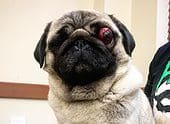While puppies’ eyes remain closed for the first few weeks of their lives, all puppies are born with eyes that appear blue, as the eye pigment known as melanin has yet to fully develop.
However, if you’ve never had a litter of puppies before, you might be wondering: When do puppies’ eyes change color?
In this article, I will cover some important information about the color of puppies’ eyes, including why puppies are born with blue eyes and when their eyes change color.

So, let’s get into it.
If your dog has a litter of puppies, when they are newborn, you might be surprised to learn that their eyes don’t open right away. Puppies’ eyes remain closed for the first 8 to 14 days of their lives.
During this time, they will effectively be blind and will use their paws and nose to feel around their environment and will stay very close to their mother during this time.
Following these first few weeks, your puppy’s eyes will begin to slowly open. As a puppy’s eyes are beginning to open, their vision will also slowly develop, albeit hazy during the first few weeks.
After about three to four weeks, your puppies will be able to see things more clearly and will begin to behave more independently from their mother.
Why Are Puppies Born With Blue Eyes?
Puppies are born with blue eyes due to a lack of melanin in their irises, which has yet to fully develop. The melanin in their eyes only begins to develop as they get older.
Once your pups open their eyes for the first time, they often appear as a foggy shade of blue. However, just like babies, eye colors can vary from puppy to puppy.
The exact shade of blue will depend on the dog, as this can vary from breed to breed and relies on other characteristics than you might first initially think of.
It will take several weeks for the melanin to develop in your puppies’ eyes, but it pays to keep a close eye on your puppies at this early stage in life so that you do not miss out on them changing color.
Although a puppy’s eyes typically look bluish when they are born, they are actually more of a clear color.
Blue in a dog’s eyes, then, is not a color, but is instead is the absence of color. The blue appearance in their irises comes down to absence of melanin in their irises coupled with the refraction and reflection of light.
Melanin is what gives color to a dog’s skin, coat and eyes. It protects the cells by trapping light rays, preventing them from harmful radiation. The more melanin they develop in their eyes, then, the darker they will become.
A dog with brown eyes, for instance, has the most melanin.
When Do Puppies’ Eyes Change Color?
Puppies’ eyes start to change color when they are about four weeks old. It can take between 9 to 16 weeks for your puppies’ eyes to change color, though, for some puppies to reach their mature eye color.
After this point, your puppy’s eyes should now be the permanent color that will remain into adulthood. If their eye color hasn’t changed within this timeframe, then it is highly likely that their blue eyes are here to stay.
However, you do need to be wary of your dog’s changing further down the line due to health conditions.
Why Do Puppies’ Eyes Change Color From Blue?
Eye color among dogs varies, and just because you suspect you have a good idea of the color your puppies’ eyes will turn out to be, doesn’t mean that you’ll always be correct on the matter.
Melanin plays a fundamental role in determining the color a puppy’s eyes will change to. However, there are also other factors that can affect their color, including their coat color.

For instance, puppy’s with merle or dappled coats are more likely to retain their blue eyes into adulthood. This comes down to the fact that the merles gene works to dilute the melanin pigment, making blue the permanent eye color.
In addition to this, dogs with merle coats can often experience random mutations, sometimes displaying two different colored eyes, which is a condition known as heterochromia.
Some of the breeds that are commonly known to have merle genes include the Catahoula Leopard Dog, Australian Shepherd, Rough and Smooth Collies, Shetland Sheepdog, and the American Foxhound.
Puppies born with liver-colored coats may have a gene that also determines their amber-colored eyes. The amber eye color may range from a light brown to yellow or almost grey, like you often see in the breed of dog the Weimaraner.
However, unlike other breeds, Huskies are unique in the fact that they do not need to inherit these blue eyes from their parents. Research has found that a mutation that occurs near a gene called ALX4 which is found on canine chromosome 18 is strongly associated with blue eyes in Siberian Huskies.
This genetic change has been known to decrease pigment production in the eye. As a result, then, the lack of pigment in the iris causes the eye to appear blue in Huskies.
Can You Predict The Color Of Your Puppies’ Eyes?
Predicting the color your puppies’ eyes will be can be tricky. However, you can get a good idea simply by looking at the parents and taking their breed of dog into consideration.
Certain breeds are more likely to have brown eyes, whereas others are more likely to have blue eyes.
A few breeds that commonly have brown eyes include Pomeranians, German Shepherds, Labradors, French Bulldogs, Beagles, and Golden Retrievers.
That being said, it’s important to know that any breed of dog can develop brown eyes. As the most common eye color, it is more likely your puppy will develop this color in comparison to any other eye color.
In addition to this, as I’ve mentioned above, the color of a puppy’s coat can help to indicate the color that your puppy’s eyes will be.
Therefore, puppies with darker coats often have a higher chance of developing darker eyes, whilst puppies with lighter coats are more likely to have lighter colored eyes.
In some rare cases, dogs have developed blue eyes even in breeds that show no characteristics of having blue eyes.
Such a scenario mostly occurs when a breed like an Australian Shepherd or a Siberian Husky is involved and bred with another dog.
Huskies and Australian Shepherds often have blue eyes or even two different colored eyes thanks to heterochromia.
Puppies And Heterochromia
Heterochromia is when a dog’s eyes are different colors. Not only does heterochromia affect dogs, but it also occurs within humans, cats, and horses. Heterochromia isn’t found in all breeds, but is commonly found in breeds such as:
- Border Collies
- Siberian Huskies
- Dalmatians
- Great Danes
- Australian Cattle Dogs
- Australian Shepherds
- Chihuahuas
- Shetland Sheepdogs
- Shih Tzus
That being said, heterochromia is most commonly found in Siberian Huskies, Dalmatians, Australian Cattle Dogs and Australian Shepherds.
Puppies can develop heterochromia in two different ways. It can either be inherited genetically from a puppy’s parents or caused by a random mutation.
It’s also important to note that there are a variety of different forms of heterochromia that can be present in your dog, including complete, central, and sectoral heterochromia.
Complete heterochromia is when a dog has one eye that is a different color from the other.
Central heterochromia is when there is a haloed pattern in the iris that is a different color to the rest of the iris.
In contrast, sectoral is when only part of a dog’s iris is blue, with the rest of the eye being a different color.
Generally speaking, heterochromia is nothing to worry about. However, a dog can develop heterochromia in the later stage of its life due to some health conditions such as cataracts, glaucoma, and retinal dysplasia.
Staying in tune with your dog and keeping an eye on the changing color, pattern, and shape of your dog’s iris can help you to notice if something seems abnormal.
If you see or note any unusual changes in their eyes or their behavior, make sure that you consult with a veterinarian and get the right treatment to ensure the overall health and well-being of your dog.
In most cases, there will be no concerning disease or condition causing the eye color variation. However, it is important to rule out these conditions to ensure that your dog is in the best health possible.
That being said, if your dog’s eyes suddenly change color when they are already matured and you are concerned about your dog in any way, it is best to get their eyes checked by a veterinarian.
Your veterinarian will be able to examine your dog’s eyes to determine what has caused the heterochromia and rule out whether it is anything sinister that needs further medical attention.
If there are no other issues with your dog’s eyes or their eyesight, then it might be that no treatment may be needed. However, it’s better to be safe than sorry.
Seeking professional advice is always the best option when you’re anxious about the health of your furry friend and it will also provide you with peace of mind.
What Is The Most Common Eye Color In Dogs?
The most common eye color in dogs is brown. This simply comes down to the fact that the color brown is dominant in certain breeds and is therefore passed down from one generation to another.

Dogs with brown eyes have a larger concentration of melanin in their iris, while dogs with blue eyes have much less. Some dogs have darker hues of brown, and others show lighter brown shades.
Next to brown, amber is the second most common eye color found in dogs. As I have discussed previously, the amount of melanin in the eyes determines how dark the color of your dog’s eyes become.
Dogs with amber eyes, then, have slightly less melanin in their iris when compared to brown eyes.
The rarest eye color that you will see in dogs is present in dogs with heterochromia. As I discussed above, there are many kinds of heterochromia that can appear in dogs, and the amount of melanin determines the color in each eye.
In Summary
It’s a special occasion when your puppy opens their eyes for the first time and you get to see the color of your puppy’s eyes for the first time.
That being said, a puppy’s eye color starts to change color when they are about four weeks old. It can take between 9 to 16 weeks for your puppies’ eyes to change to their permanent color.
However, you can make predictions of their permanent color by looking at the color of their parent’s eyes and their breed and coat.
It’s important that you have a good idea of what your dog’s eyes usually look like. If you notice any sudden changes in the color of your dog’s eyes, it is best to seek professional advice and get them checked out by a veterinarian.
Your vet will be able to examine your dog’s eyes and determine whether there is an issue that requires treatment.
When it comes to your dog’s eye health, it’s always best to leave it up to the professionals.

